|
|
 |
Canadian Historic Sites: Occasional Papers in Archaeology and History No. 26
Grubstake to Grocery Store: Supplying the Klondike, 1897-1907
by Margaret Archibald
Satisfying the Sourdough Appetite
To the family:
Laura may tell Frank Gross that we disposed of
that pail of ham the same as we do of all grub, eat it up very quick.
The dried fruit that his mother gave me went the same way, and all that
Mother sent except the cherries. We have a lot of dried apples, peaches,
apricots and such stuff we bought in Seattle. I do not miss the grub we
have at home as much as you would think, but I will probably have a good
appetite for it by the time I get home next June.1
And so he probably would, for this miner, writing
from Sulphur Creek in June of 1898, still had a long way to go on the
crest of his optimism. His cache of dried fruits and vegetables, bacon
and flour was still good; he would probably depend on these staples for
his winter survival. While there were, of course, more interesting foods
on the market in Dawson, the creek worker could afford neither the time
nor the money to procure them.
Winter thawing was a long, tedious, back-breaking
task — one which is too rarely brought to mind by the romantic
concept of digging for gold. Only one man was released from this work at a
time to take charge of cooking, a chore which in some cases involved no
more than cooking up quantities of sourdough bread and beans. Cooked
beans could be left to freeze solid; the cook could then hack off a
chunk of them with an axe and heat them in skillet grease when
necessary.2 These solid victuals were consumed along with
bacon and coffee, tinned or dried fruits and vegetables when they were
available. For that first winter, at least, it was sourdough bread and
brown beans — not the excitement of scooping nuggets from creekbeds
— which kept the Klondiker's body and soul together. The first of
these staples, sourdough, was such a thoroughly rooted Yukon tradition
that it lent its name as a sobriquet to the Yukon old-timer.
"Sourdough" described the pungent taste and smell of the fermented
paste, or starter, which was used to start the leavening of dough. Why
the name was earned by anyone who had spent one winter inside has never
been successfully explained.
There were innumberable possible variations for the
baking of sourdough bread. Two follow. The first recipe was used by
Martha Louise Black in her earliest days in the Yukon. This recipe
employs the traditional starter, a rising agent made ahead of time
without the benefit of store-bought yeast. A small amount of starter was
saved each time for subsequent bread-making:
Mix a thin batter of flour and water. Add a little
rice or macaroni water and a pinch of sugar. Put mixture in a pail,
cover it and hang over the stove, keeping it warm for four hours.
Sourdough may be used to raise bread, pancakes and doughnuts. For
pancakes use a pinch of soda.3
The second recipe was included in his diary by a
Sulphur Creek miner.
6 cups flour
5 tea spoons baking powder
2 tea spoons salt
mix well
4 cups water4
The final traditional Klondike touch came with the
baking, for the bread pan was the prospector's gold pan. With more
modern methods of working dumps, the miner's pan was relegated to what,
up to that point, had been its secondary functions as a vessel for
baking bread and washing up.
The only food which could rival bread as a dietary staple was brown
beans,
which exactly ressemble [sic] the ordinary beans supplied to
horses, and require boiling for about 3 hours before they become
sufficiently soft. They possess strong nutritive and heating properties
and in those days, when meat could only be obtained at fabulous prices,
were consumed in enormous quantities. They were not unpleasant to eat
when there was nothing else, and went by the name "Yukon
Strawberry."5
Such a dispassionate observation must have
come from a man who wintered on something of a deluxe outfit.
Even a full stomach of bread and beans was not enough. The constant
exposure to cold, the unrelieved monotony of mining, the dark, airless,
unhygienic cabins and the endlessly repeated menu all contributed, if
not to scurvy, to a most depressing physical condition. As late as 1900
a boy wrote from the creeks,
Happily the cold air and the work do sharpen our appetites and we
could relish sawdust and garlic.
The succulent (and flatulent) bean is the mainstay of the miner
during the winter. In Dawson, one can feast on oysters, frogs' legs,
fresh eggs and beef, but on the creeks, while we may sigh for such
delicacies we are content to feed on the meat of moose or caribou,
bacon, canned mutton or canned roast beef.6
Moose, caribou and smaller game as well as fish in season were some
of the few concessions made by the Yukon to provide for these newcomers.
Even then, such concessions were not direct ones. If cheechakos were not
suited to the arduous miner's life, they were even less competent as
self-sufficient men of the bush. The inclusion of bacon and tinned meats
in an outfit was presumably intended to free the goldseeker from the
necessity of hunting. When the tinned meat ran out and the bacon became
unbearable, the cheechako could obtain game from the natives who had,
until recently, depended on it themselves. With their moose pastures
overrun by foreigners and alien gold-extracting equipment, many of these
bands had turned to exchanging their game for the gold they had
previously ignored. One band camped at Moosehide each summer to be
nearer the lucrative market at the Klondike's mouth.7 Winters
were particularly productive, for during that season native life was
"enlivened by quick trips to Dawson and the mining camps to sell meat at
inflationary prices."8
Throughout the year, weekly newspaper reports of fish and game prices
were regular features of the Dawson commodities market.9 One
sourdough recalled that caribou meat was tender and palatable, but less
energy-giving than moose, beef or pork.
It doesn't stay with one as long. Moose has all the consistency of
beef and is the same. The bulk of the meat is ... stringy but the steaks
are equal [to] beef steaks. It may be kept [frozen] in summer for
as long as required by placing in glacial streams.10
Some of the more fastidious urbanites who had rushed to the
goldfields ignorant and unquestioning were somewhat squeamish about
eating fresh game.11 Too late they realized that fresh meat
of any sort was all too rare an occurrence in the early Dawson
market.
One assistant surgeon for the North-West Mounted Police was very much
aware of the positive relationship between varied diet and high morale
among his men. As late as 1900, isolation and the lack of diversion were
considered by Dr. Paré to be a serious danger to the mental health of
the force. To counteract these conditions, he ordered that rations be
made as appetizing as possible, even though most food still came from
tins. "It is a daily and amusing sight," he remarked, "to see them going
to their mess with cans of peas, corn, fruit, cream, milk, bottles of
pickles, sardines, etc."12
The territorial health officer in 1899, Dr. J.W.
Good, was similarly concerned about the well-being of Dawson's
predominantly male population (80 per cent of the population in
1899).13 If more women came north, he reasoned, their talents could be
turned to raising vegetables, chickens and cows. The positive
influence of family life in Dawson would put an end to scurvy once and
for all.14
One northern woman who agreed with Dr. Good's
philosophy was Mrs. Clarence Berry, the wife of one of Dawson's original
Bonanza kings. She had accompanied her husband over the pass in 1895
because she thought that women had an essential role to
play in the goldfields, cooking for their men to
prevent sickness and stomach-aches. She strained her imagination to
produce a wholesome diet out of tins, yet despite her efforts, she still
pined for anything fresh, raw or green.15
Martha Louise Black found her culinary talents
similarly challenged by the limitations of an outfit and a general food
shortage in trying to cook decent meals for lonely and hungry miners.
This is Thanksgiving month, and I am going to celebrate with a
dinner. It is difficult to cook here, with granulated potatoes,
crystallized eggs, evaporated fruits and vegetables, canned meat and
condensed milk, but I have made mincemeat and it is prime. 16
She came up with the following menu:
Canned tomato soup — Bread Sticks
Oyster patties — Olives
Baked Stuffed Ptarmigan
Canned Corn — Dessicated Potato Puff
Bread — Butter — Pickles
Mince Pie — Cheese — Coffee
Popcorn Balls — and a taste of your Home
Fruit Cake (the larger part to be saved for Christmas).
In the isolated winter life of a miner,
Thanksgiving, Christmas and New Year were bright moments indeed, moments
when the cabin walls seemed less confining, the surrounding wilderness
less oppressive. Such occasions called for cabin-to-cabin socializing
— something of a luxury in itself, when there was thawing and
digging to be done. Friends from the same hometown might get together
in one cabin to sing and dance and eat as fine a meal as could be
assembled from the best of the combined outfits.17
Roast moose often took the place of turkey,
accompanied by the traditional cranberry sauce, if someone had managed
to hoard a little.18 Mince pie or plum pudding was another
special treat, pulled from a corner of the cabin where it had been
stored for the occasion. For one group of miners, the celebrational
dinner consisted (by necessity) of dried potatoes, bacon, rice, evaporated
fruit and their last can of tomatoes as a treat.19
In recording this dinner in a letter to his sister in
England, a young miner reflected unhappily that whatever Dawson had for
sale lay far beyond the reach of an ordinary miner working a claim deep
in the Klondike valley. By the fall of 1898 the city boasted both
specialized and general retail establishments which were known for their
choice merchandise. In fact, one resident of Dawson and the creeks
from 1898 to 1901 declared that "there was little you couldn't get there
provided you had the money."20
Most Dawson residents, however, were as limited by
economic considerations in their choice as were the workers on the
creek-beds. They too grew tired of tinned goods, the inescapable
social leveller. Long after the outfits purchased in Vancouver had run out
and Dawson warehouses had been fully stocked in all lines of new goods,
tin cans continued to dominate Dawson's shelves — as well as its
hillsides.
As we approach the confines of the town the chief
object that attracts the eye is the immense number of empty tin cans of
every size and description, which lie in thousands upon all sides of the
innumerable log cabins dotted about on the rocky hill slopes. The poorer
inhabitants appear to live exclusively on canned food and there is
surely here a great field open for an enterprising inventor who can put
the masses of empty tins, which are thrown away in such quantities, to
any practical use. The motto "One people one tongue" much quoted in
Dawson, evidently refers to the canned commodity which forms the staple
food of the Anglo-Saxons of the city. 21
Fruits, vegetables, milk and cream, butter,
crystallized eggs, meats, fish (especially salmon), soups, baking
powder, yeast, baking soda, cocoa and coffee had all been sealed, at one
time or another, in those metal containers which lay strewn outside
Dawson cabins. Baking powder tins, because of their size (a 2-1/2 lb.
"Imperial" tin was 8 inches high and 4-1/2 inches in
diameter)22 were used as storage tins in the kitchen. Laura
Berton recalls that miners often stored their gold dust in these large
cans.23
Yukon sourdoughs seem to have developed one common
characteristic as a result of their first qualifying winter inside. Each
one acquired a lifelong and unshakable loathing for one particular dish
on the Dawson menu. For many it must have been one of the types of
evaporated vegetables. The humble turnip may indeed have had the power
to prevent scurvy, but it seems unlikely that it won many admirers in
the Klondike in its evaporated form.
The granulated or dried potato was another item
which, like the brown bean, won less than enthusiastic acceptance on
Yukon dinner tables. "Lubeck's" German sliced potatoes led the
field. The white substance, which rather resembled rice, was soaked in
cold water and then doused with boiling water; so softened, it could be
fried in bacon fat or butter.24 Perhaps the widespread use of
the granulated potato in Dawson is best illustrated by the fact that the
whole fresh potato was set apart by a special name, "cheechako potato,"
as being new to the territory. It was an expensive novelty at that. In
1899 one man who struck a rich claim celebrated his sudden wealth by
splurging on fresh potatoes. He
bought 100 pounds which, at the prevailing price,
would have cost him $25. Ella Hall, who recorded the event, felt
especially elated because, as a friend, she had received some of the
treasured tubers.25 By 1902 whole potatoes (as well as
onions) were available year-round and "Lubeck's" registered a distinct
decline in sales.26 The price of fresh potatoes had dropped
from the 25 cents per pound which the rich miner had paid three years
before to a steady 9 cents per pound in 1902.27
The advent of cold storage in Dawson had had a
decisive effect in enlarging the range of the city's diet. Cheese,
butter, eggs, apples, citrus fruits, bananas, fish, poultry, meats, root
vegetables and grains could all be kept in this say anywhere from 6 to
12 months.28 Dawson, like the rest of Canada, was
experimenting in a new process in dealing with
perishables.29 Across the country cold storage was greeted
with general public discredit; most consumers insisted on "strictly
fresh" goods.30 But the northern customer was, unlike his
far-off countrymen, in no position to make such demands. Cold storage
had reintroduced whole meat into his diet and had rescued him from a
life time of "Lamont's" crystallized eggs, "Lubeck's" evaporated
potatoes and J.B. Agen's canned preserved butter.
On the other hand, creek workers who continued to do
their shopping in Dawson on a twice-yearly basis kept the canned meat
and vegetable trade flourishing.31 A good week of frozen
trails in the fall meant heavy purchasing traffic from the creeks, and a
noticeable strain on the supplies of "Reindeer" milk or canned peas and
beans.
Still, many comparatively privileged Dawson residents
found that, after a few years, even cold storage food acquired a sameness
in flavour which made one crave the "strictly fresh." Martha Louise
Black yearned for dietary escape from the ten-month-old-egg. Mrs. Black
(who was by this time the wife of Commissioner George Black), was
adventurous enough to decide that she would have to raise her own
chickens if she was to have fresh eggs on a regular basis. Accordingly
she sent to Vancouver for six dozen hens. Each and every fresh egg she
relished, until she found out that the chickens had not prospered in the
northern climate; all along her husband had been buying crates of the
same cold-storage eggs which she believed that the gardener was
delivering "fresh from the hen-house."32
The type of food which cold storage really freed from
the confines of tin cans was meat. Without the benefit of
refrigeration, Dawson had no access to the products of southern
slaughter houses. The only alternative was to ship in livestock,
butcher it in Dawson and freeze the meat on the spot. This was no simple
matter, given the obstacle course between Dawson and the
coast which had defeated beasts far more agile than
beef cattle. Jack Dalton spent his gold-rush days laying a trail to
skirt the passes on a wide sweep from the Lynn Canal to Fort Selkirk.
For over 300 miles the footpath was long and rugged, but it avoided the
treacheries both of the mountain pass trails and the upper river rapids.
During the summer of 1898, some 2,000 beef cattle were herded over this
route to the river.33 When the overland trail from Whitehorse
to Dawson was completed in 1902, herding was made even easier. During
the winter, the stock was slaughtered at Whitehorse to save on additional
feeding, and the frozen beef, pork and mutton were shipped over the ice
from there.34
The greatest material improvement in Dawson meat
provision was made by the Arctic Meat Company in 1899. A 250-horsepower
steamer, the Lotta Talbot, was fitted out with liquid ammonia
refrigeration compartments. She was constructed to make both the Pacific
voyage from Seattle to Saint Michael and the shallow river journey up to
Dawson. After a little more than two months of travel she arrived at the
Dawson wharves, offering wholesale or over-the-counter meats to the
city. The meat sold by this Puget Sound company was reputedly killed in
its prime rather than after being driven to exhaustion over icy
trails.35
By 1901 a similar firm, the Pacific Cold Storage
Company, had entered the country from Tacoma, Washington, with both
sea-going and river refrigeration steamers. It offered public storage and
wholesale meat supplies at all points along the Yukon River as far
upriver as Dawson. Meat was also brought in by the WPYR, which, by the
same year, had installed special cars for transporting perishables.
At Whitehorse, the Canadian, the Columbianor the
Yukoner lay in berth to carry the refrigerated cargo down to
Dawson.36 With this modernization of cargo carriers, Swift
and Armour, both large American meat distributers, could look to Dawson
as an extension of their commercial empires.
The prospect of local ranching had been discouraged
from the start by the scarcity of nearby grazing land and a short and
uncertain growing season. A red-topped hay grew wild in some Yukon
valleys and meadows, but such fertile patches tempted only the hardiest
ranchers.
Much more successful experimentation in both
agricultural and monetary terms was done with vegetables. Such
experimentation was not a recent phenomenon in those latitudes. One trader,
Arthur Harper, had persisted in growing vegetables at every yukon post
at which he served.37 Small sandy plots were ideal, and while
the growing season was, of course, short, the long hours of daylight
could be relied on to produce unusually large vegetables.38
Nonetheless, the factor which most encouraged
the success of Yukon market gardening was the
ready-made market of eager Dawsonites.
C.M. Bartholam and James A. Acklin were two
entrepreneurs of 1898 who foresaw the effect of fresh produce on a
population hitherto dependent on tinned goods. Cultivating land just
above Dawson on the Klondike River, Acklin tried out various types of
lettuce, cabbage, cauliflower, radishes, peas, spinach, mustard, "sweet
peas," carrots, turnips, pea and string beans, onions, beets, rhubarb
and rutabagas.39 Like Acklin, Bartholam discovered that
there was more than one way to extract gold from the Yukon's banks. One
of the first water pails of greens from his Klondike River plot sold for
more than $100 to a northerner starved for fresh
vegetables.40
By the next harvest season there were 12 local
gardeners concentrated in the valley around Dawson, the Klondike River,
the flats at the river's mouth (near the Ogilvie Bridge) and the area
across the Yukon known as West Dawson.41 From that time on,
the city's summer residents were treated to fresh vegetables of all
kinds. In addition to those successfully cultivated by Acklin, local
strawberries were particularly good as a cash crop: a small box always
sold for more than a dollar.42 Potatoes, although prolific,
were never considered mealy enough to contend seriously with the cold
storage variety. Early frost and old seeds from the outside were
additional problems which hampered the immediate success of market
gardening.43 Nevertheless, Dawson consumed everything that
was grown in both market and private gardens. Even in competition with
fresh goods rushed in over the ice, early local lettuces and radishes
sold out as soon as they appeared on the market each
June.44
But fresh vegetables retailed at an average price of
12 cents per pound, and not everyone could afford them. Restaurants
found themselves tied in the same way to tinned goods because of the
prohibitive prices of local fresh merchandise.45 In four
years, however, the status of homegrown products had changed;
Commissioner Lithgow claimed in 1906 that importation of turnips,
carrots, beets and celery had almost ceased.46 The evaporated
vegetables seem mercifully to have passed by 1907, but tinned fruits and
vegetables were still regarded as staples. Dried fruit remained a
popular item as well.
In the realm of grains and cereals, Dawson's tastes
changed little during and after the gold-rush. Flour and rolled oats
were still staples. While there was an increasing number of bakeries in
town (the 1902 directory lists 13), breadmaking held its place as a
normal kitchen activity, especially in the growing number of homes where
wives had come north to supervise miners' eating habits.
There was one major change in cereal products which
registered as something of a fad across the continent during this period.
The idea of prepared breakfast foods, which began with the boxing of
"Quaker Oats" as early as the 1870s, had taken hold.47 By
1903 a substantial corner of the Dawson grocery store was needed for
boxed cereals, if the storekeeper intended to keep up with the almost 20
brands which were available to the market (see Appendix B). Steamed
cereal was considered an especially sensible way to start a Yukon winter
morning.
A major advance in the Dawson grocery trade after the
gold-rush, and one of which merchants were visibly proud, was the
increased range of specialty items or luxury goods which brightened the
rows of shelves. Many of those who reported spartan Christmas meals in
1898 would not have to repeat the menu the next year. Once his first
outfit had been consumed, the customer could take advantage of the many
delicacies which were advertised at the Christmas season. Besides the
turkeys and plum puddings which were expected at most tables, the Dawson
merchant made the most of his fancy stocks of wines and wafers, special
apples and raisins, nuts and biscuits, candied fruit and other such
treats in boxes, tins and bottles. "Crosse and Blackwell" figured
prominently in these seasonal advertisements for luxuries which would
have seemed too expensive at any other time of year.48
Foreign names abounded as candy and prunes from France, oranges, grapes
and raisins from Spain or Turkey and nuts from South America made their
special appearances in the showcases.
Also in step with the times were the menus in those
Dawson restaurants which maintained any pretence to elegance. The menu
of the Holborn Cafe in the spring of 1900 offered such delicacies as
oyster cocktails and lobster salad on mayonnaise, queen olives, eastern
shad au gratin, fricandeau of veal à la macedoine and English
plum pudding with brandy sauce.49 All one can hope is that
the elaborate names were accurate descriptions of better and more
appetizing food than the beanery meals of 1898 had been.
For those who preferred and could afford to prepare their own
gourmandises, speciality items were available all year round. One
advertisement from the Ames Mercantile Company in 1900 offered the
consumer everything from shrimp in tomato sauce, devilled ham and vienna
sausage to French prunes, pitted plums, New Orleans molasses and fancy
table syrups. In fact it seems, from scanning grocery lists in
Canadian Grocer and Eaton's catalogue, that the average Canadian
at the turn of the century had a greater craving for fancy fruits,
jellies and condiments in pots, tins and bottles than do his descendants
today. Stanley Scearce, a Dawson commission merchant and importer,
appeared to dominate the field of fancy goods in 1907. His store stocked
items which ranged from "Cresca" stuffed dates to "Averbach" German
truffled liver. He also advertised peanut butter, which made its first
appearance in Dawson around 1907. For a large jar of the substance
Dawson consumers paid one dollar.50
To speak of "imports" to the Dawson market can be
somewhat confusing for the word has a variety of connotations. Foremost
in the mind of the average resident was the fact that nearly all goods
had to be imported from far beyond the Yukon's borders. As the awareness
of Dawson's vulnerability to American goods increased, "import" came to
refer to goods from American rather than Canadian producers. In the
field of fancy groceries, the word "import" maintained the idea that the
item came from distant ports.
By 1902 several influential articles had pointed out
to Canadian manufacturers the extent to which the Yukon diet was
dependent on American goods.51 Tinned goods, packaged dairy
products, ham, bacon, lard, flour and evaporated vegetables were areas
which were primarily supplied by American sources. Most dairy products
and flour came from Washington and Oregon and most fruits and
vegetables from California, although Australia and New Zealand provided
some of these goods. The competitive Canadian products in these fields
(especially dairy products) usually came from Ontario, as did many
overseas shipments of such things as teas, coffees and dried fruits, and
were distributed by centrally located jobbers there.52
The quality of the edibles on the cabin shelf had
vastly improved since the concentrated and dessicated days of 1898. But
beans and canned goods might continue to dominate many a table over the
next decade, for not every miner could afford paté de toie gras
from Stanley Scearce. Still, those merchants who advertised regularly in
the local newspapers in 1902 appeared to have had an extraordinarily
wide variety of stock, even in staple items.
These advertisements were interesting for their lack
of convincing rhetoric and descriptive journalism. Mere lists of goods
and prices sufficed in most cases. By 1902 some brand names were
mentioned, but no consistent and focused effort was made to sell one
brand of goods in any line. The popularity of one brand was often
inferred only through repetitious references by more than one store; by
this means one can presume the success of such brands as "Rex" meats,
"Heinz" and "Crosse & Blackwell" products, "Ogilvie's" flour, and
J.B. Agen's butter. Over the years only a handful of manufacturers and
distributors advertised their goods directly in Dawson newspapers.
"Lamont's Crystallized Eggs," "Hand--Y Brand"
evaporated fruits and vegetables, "Blue Ribbon" and "Salada" teas,
"Durkee's" spices, "Libby, McNeill and Libby," "Clark's" meats,
"Ogilvie's Blue Label" flour and J.B. Agen's butter were among the few
products which were advertised in this way (Figs. 37 and 38). After 1902
this practice occupied increased space in the pages of the Dawson
Daily News.
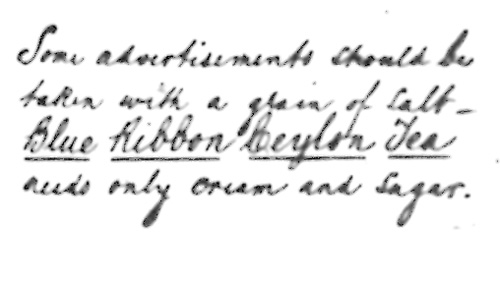
37 "Some advertisements should be taken with a grain of salt —
Blue Ribbon Ceylon Tea needs only cream and sugar." A common
advsertisement in the Dawson Daily News in 1902.
(Dawson Daily News, 10 June 1902, p. 3.)
|
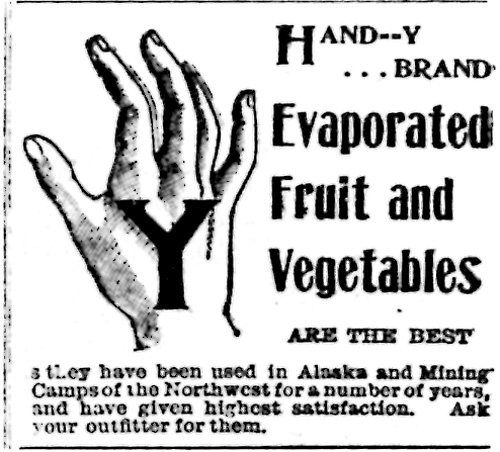
38 "Hand--Y" brand evaporated fruit, advertised in the Klondike
Nugget in 1898.
(Klondike Nugget, 16 June 1898, p. 4.)
|
The more popular method of advertising was done
directly through the retailers of the product.53 In his own
store the merchant felt the greatest responsibility for the sales of
certain brands of goods. As technology in the last half of the 19th
century brought both the packaged product and the widespread marketing of a
recognized brand name, the manufacturer and distributor encouraged the
individual merchant to vouch for his product. The storekeeper, it was
reasoned, would appreciate the increased efficiency in handling (e.g.,
packaged cereals as opposed to bins of rolled oats) as well as a
reliable clientele if he stocked only one company's goods.
The transition made a tremendous difference to the
store's interior. Shelving became the primary method of display, since
the majority of products were in tins, bottles and packages and could be
displayed that way. In addition, colourful placards, posters, cut-outs,
bunting and plaster models were obtainable from the manufacturer for the
purpose of advertising the brand name of that company's
products.54 The NC Company store displayed this kind of
interior advertising (Fig. 39) as various company-sponsored
advertisements competed for the customer's eye. Merchants with
imaginative or artistic capabilities could build a rather elaborate
display around the product, placards and models.
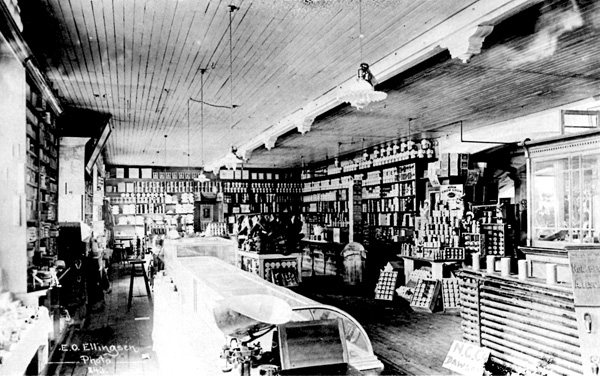
39 The grocery department of the Northern Commercial Company, 1909.
(Public Archives Canada, C 3014.)
|
Ornate window dressings in grocery stores were
particularly popular among the subscribers to the Canadian
Grocer. Photographs, hints, criticism and praise directed at
particular window displays of this or that grocer became a regular
feature between 1903 and 1905. The accompanying articles stressed time
and again the importance of imaginative visual appeal in these displays.
It appeared that great pyramids of packaged products surrounded by large
placards bearing the company's name, along with sundry related
decorations, formed a most popular genre of window dressing (see
Fig. 40). While Dawson photographs offer glimpses of small piles of
goods in the window (Fig. 41) there seem to have been no grand
expositions on the British model suggestive of those in the Canadian
Grocer. This may, however, be the result of a gap in the pictorial
record of the city rather than a lack of sophistication on the part of
the merchants. The fact that many of the smaller stores opened out onto
the sidewalk for the light summer months may also have
limited window display (Fig. 42).
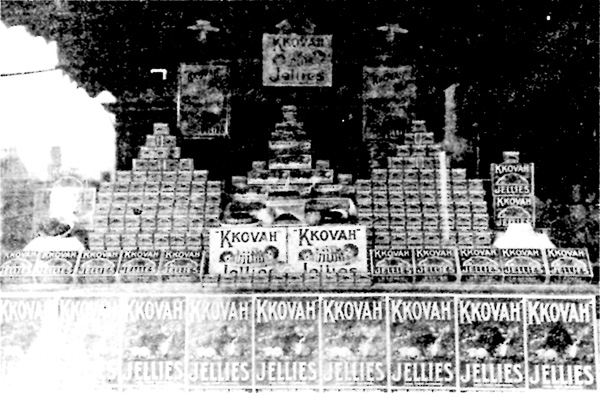
40 An exemplary grocery window display
(Canadian Grocer, Vol. 17, No. 50 [Dec. 1903], p. 50.)
|
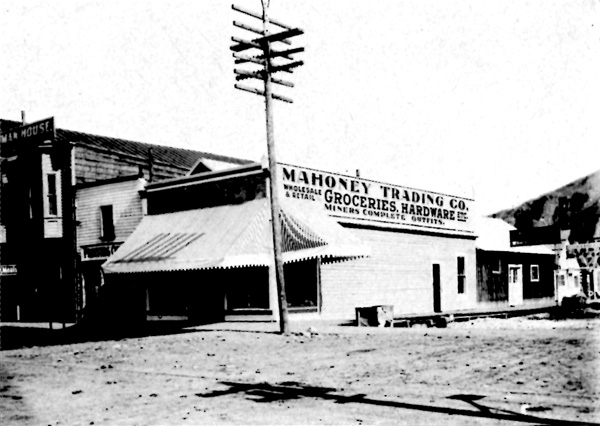
41 The Dawson grocert did not always pay as much attention
to his window displays as did his southern counterparts.
(Public Archives Canada, PA 13279.)
|
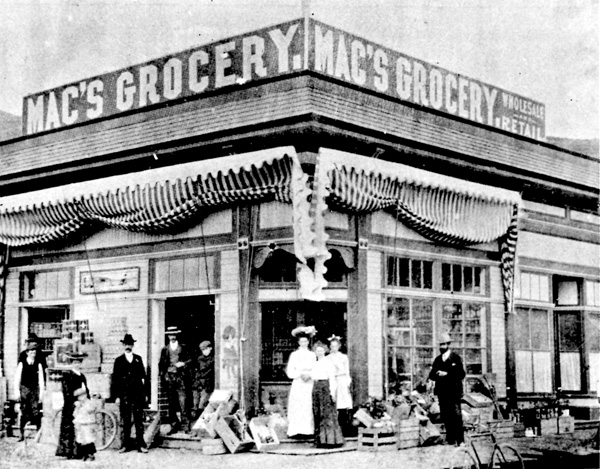
42 Mac's Grocery, 1903-05. Dawson stores extended to the
sidewalks in summer.
(Public Archives Canada, C 7068.)
|
The interior appearance of any well-appointed store
was thought to be an essential factor of good salesmanship. In this
matter the Canadian Grocer weekly espoused the cause of neat and
tidy displays. Now that packaging was coming into its own as a refined
commercial art, the pleasing array of goods in a store began to take
over from the chaotic floor-boards-to-rafters approach of the previous
century. "Within recent years it has become a generally recognized fact
that appearance is to a grocery store almost of the same importance
that clothes are to a woman. They are not everything but they account
for a great deal."55
As with window displays, the Grocer made a
regular feature of discussing the artistic and mercantile merits of the
interiors of various Canadian establishments (Fig. 44). The pyramid or
the three-dimensional stack of tinned and boxed products was
universally popular, relying on floor-to-ceiling wall space along one whole
wall of the store. Central display tables were used for some items,
often in conjunction with brand advertising cards. Goods to be displayed
in cartons, such as fruit, biscuits or candy, could be leaned against
these central islands, leaving the counters free for conducting
business. Showcases were also used for these sorts of goods, and in
some stores for the grain products which had previously been hidden away
in bins.
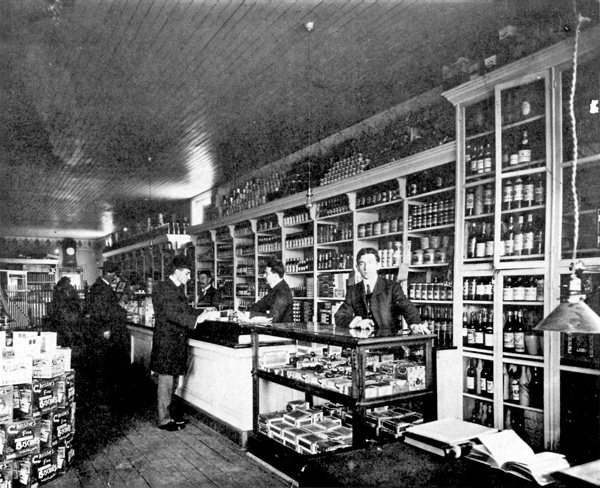
43 Grocery department, North American Transportation and
Trading Company store, Dawson, ca. 1901.
(The Library of the University of Alberta.)
|

44 A store selected by the Canadian Grocer exhibits a
popular display style.
(Canadian Grocer, Vol. 18 [July 1904], p. 53.)
|
Flat, bevelled and sloping front glass cases were
popular along the counters. In some establishments the display cases
were built right into the shelves (Fig. 45). The Canadian Grocer
had the following advice on the judicious and aesthetic use of store
space:
Barrels in sight, whatever the position may be,
are not features of a neat interior. Counters should be free from almost
all stock save what must be kept in show cases, and the office must be
well built wherever it is placed. Neatness must exist in every successful
store, and to obtain this the stock should be confined as much as
possible to the shelves, show cases and fixtures specially made for the
purpose.56
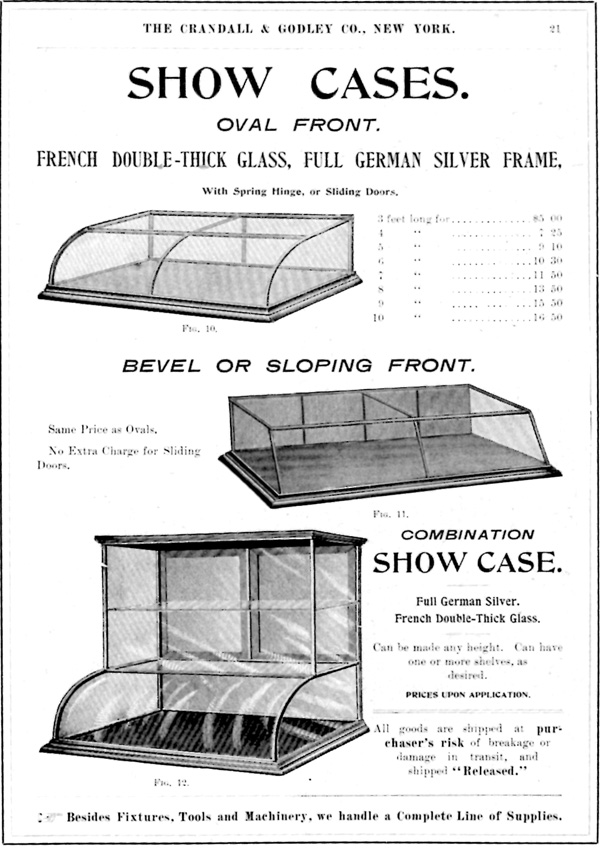
45 Glass showcases intended for confectioner's displays, 1897.
(Crandall and Godley Company, Bakers', Confectioners', Ice
Cream Makers', and Caterers' Supplies, Tools, Fixtures, and
Machinery [New York: n. p., 1897], p. 21.)
|
Photographs of Dawson's commercial interiors show a
marked similarity to those selected by the Canadian Grocer for
favourable comment. Dawson merchants were obviously determined to keep
pace with the latest display techniques (Figs. 39 and 43). In the NC
Company's grocery department of 1909 only one barrel is in evidence; it
contained ginger snaps. The cracker barrel had disappeared, and along
with it a whole style of country store-keeping. Christie's appeared to
have dominated the packaged biscuit business, but the open carton of cookies at
the end of the counter never entirely disappeared.
Like biscuits and prepared cereals, much of what had
once been bulk goods in barrels and bins appeared on Dawson shelves in
neatly and uniformly packaged units. Bulk tea appeared in 40- and
50-pound packages. Coffee beans were also available in one-pound tins or
in 25-pound sacks; the beans were ground into paper bags printed with
the retailer's name, as a common method of distribution, and the coffee
grinder never disappeared from the counter. In the photograph of the NC
Company's store, a grinder is barely visible at the far end of the
left-hand counter. While the Canadian Grocer carried
advertisements for "Coles" coffee mills from Philadelphia and "National"
mills (Eby, Blain and Company, Toronto, agents; see Figs. 46 and 47),
smaller countertop models are displayed in the Dawson Hardware Company
Museum; these are examples of the popular "Enterprise" (Enterprise
Manufacturing Company, Philadelphia) and "Swift" (Land Brothers,
Poughkeepsie, New York) coffee mills.57
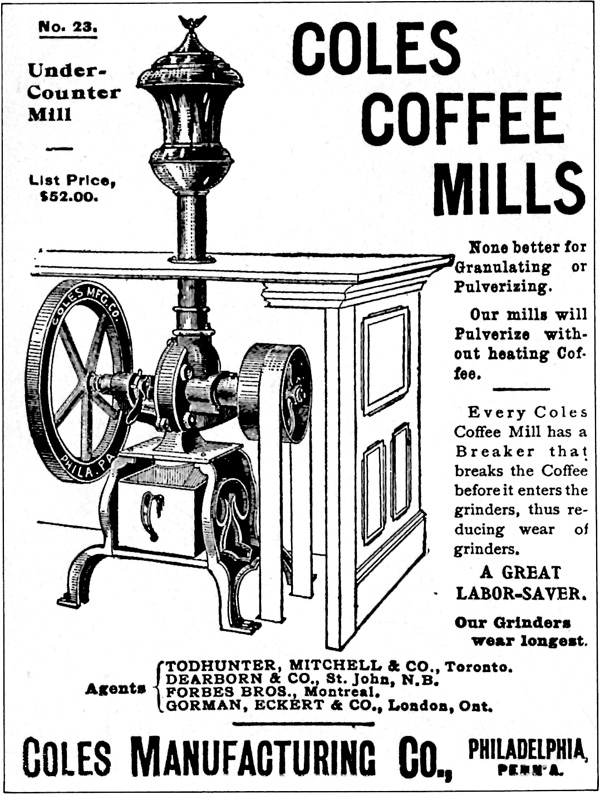
46 Coffee mill, advertised in the Canadian Grocer in 1903.
(Canadian Grocer, Vol. 17 No. 45 [Nov. 1903], p. 28.)
|
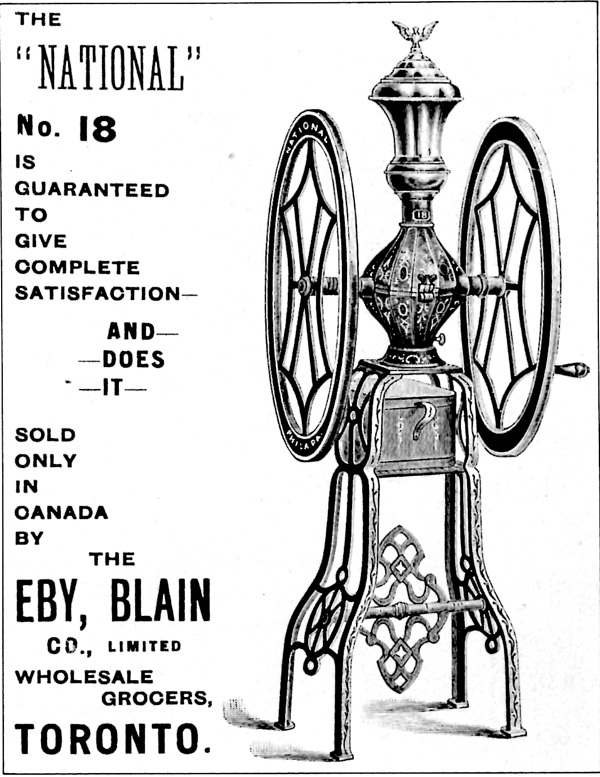
47 Coffee mill, advertised in the Canadian Grocer in 1904.
(Canadian Grocer, Vol. 18 [July 1904], p. 23.)
|
Other goods were still available in bulk form, in
addition to more modern packages. Apples still arrived tightly packed
in barrels, but they were also sold in small tins and gallon units.
While tinned butter was the only kind which arrived in Dawson at first,
cold storage reintroduced the ordinary kind in 14-, 28- and 70-pound
tubs, cases and barrels.58 Tubs from the east were most often
made of spruce. The tubs manufactured by United Factories in Toronto had
lids firmly pressed on and four encircling hoops to hold them together.
For protection from prolonged contact with the wood, the butter was
wrapped in clean cloth and then in a salt and water paste. Cheese, like
preserved butter, was most popular in the north in its prepared and
packaged form.59 MacLaren's cheeses were especialIy in
evidence, in case lots of 24 small jars or 12 medium-sized ones (Fig.
48). Stilton, "Oregon Cream," "Genuine Swiss," "Young America" and
"Ontario Twin" cheeses are recorded in 1905 market reports at various
prices per pound;60 the forms they came in, however, are not
known. They were probably sold in boxed form, for at the same time the
Canadian Grocer urged its subscribers in the cheese trade to
avoid the false economy of cheap boxes.61
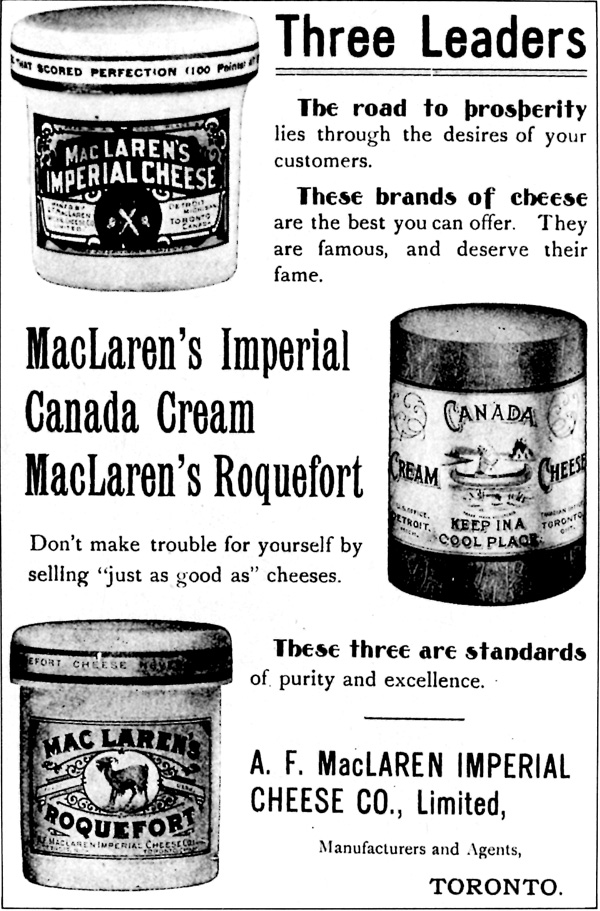
48 Three of McLaren's cheeses.
(Canadian Grocer, Vol. 19 [Feb. 1905], p. 14.)
|
Rice and flour of all kinds were traditionally put up
in 50-pound sacks, an especially convenient size for outfitting. This
size continued to be standard. In the NC Company's photograph, however,
the sacks on the left-hand back wall appear to be considerably
smaller than 50 pounds (Fig. 39), but they may have contained dried peas
or tapioca, which came in 10-pound sacks. Sugar was available in a wide
variety of forms, each with its corresponding pack. Granulated sugar
came in units of 20, 50 and 100 pounds; lump sugar came in barrels and
half-barrels; bar or loaf sugar came in 25- and 40-pound packs, and
pulverized sugar came in 25- and 100-pound barrels. Barrels and hogs-heads
of brown and white granulated sugar presented a common problem to
the merchant. The contents became so hard over a period of time that a
sugar augur had to be used to loosen the cemented mass.62
Syrup and molasses rarely arrived in the Yukon in
large kegs. "Imperial" and "Log Cabin" were both popular brands of maple
syrup (Fig. 49) and came in both 1- and 1-1/2 pound and in 5-gallon
tins. Vinegar was still available in large quantities. Most preserving
companies retailed their own vinegar in units from 1 gallon to 24 or 36
quarts. Pickled goods of all kinds were packed in wooden barrels or
smaller kegs (Fig. 50). Pickled mackerel, herring, pigs' feet, hocks
and beef, as well as the common pickled fruits and vegetables, were to
be found in this form. "Heinz" advertised a number of packing units.
Their pickles were put up in 1-, 2- and 3-pound kits, 16- and 30-gallon
barrels, 5- and 10-gallon kegs and (of course) in bottles of less than
a quart. Their motto, "57 Varieties," could be adequately vouched for in
any large grocery department (Fig. 51). Salt came in barrels, as well
as gunnies of 3, 5, and 10 pounds. Olive oil was marketed in quantities
ranging from a pint to 12 gallons; French mushrooms came in sacks of as
much as 100 pounds, and lard came in tubs of any size from 3 to 50
pounds.
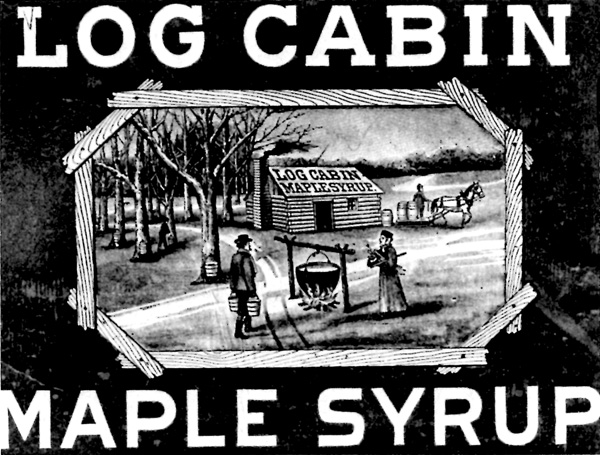
49 "Log Cabin" registered label, 1900.
(Department of Consumer and Corporate Affairs, Trade Marks Registry.)
|
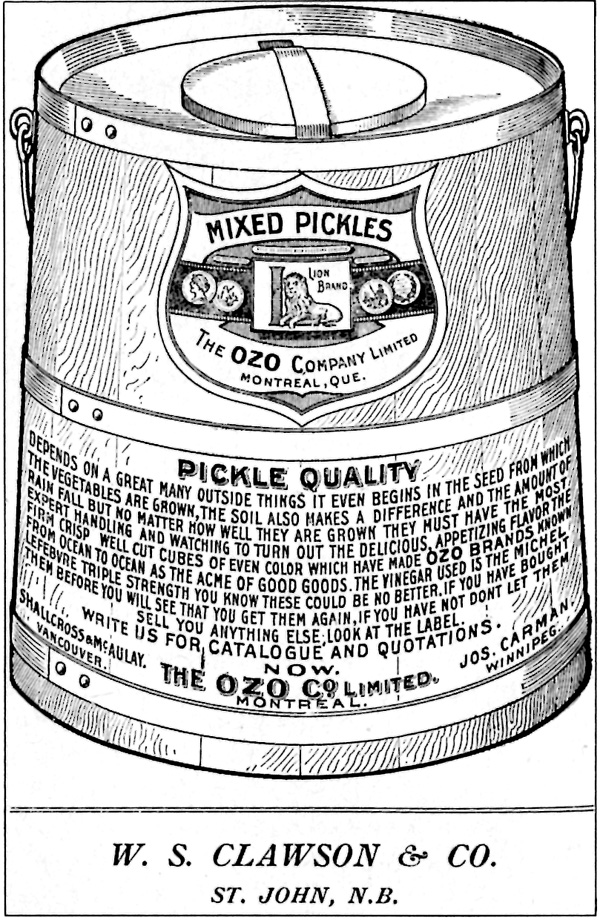
50 "Ozo" pickles, 1904.
(Canadian Grocer, Vol. 18 [July 1904], p. 56.)
|
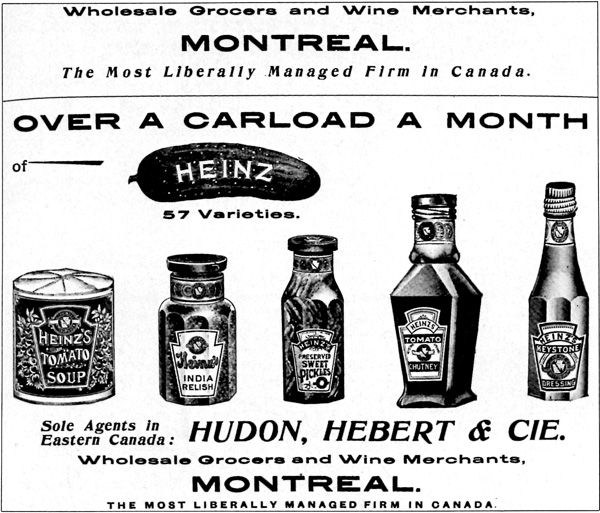
51 Five of the 57 varieties, 1904.
(Canadian Grocer, Vol. 18 [Oct. 1904], p. 146.)
|
While the shipping and retailing of products in bulk
was maintained in various lines, these too were being gradually
converted to packaged and name-brand items. Jams, jellies, sauces, olives,
mustard and other condiments were packed into jars and tins (and, in the
case of jams, pails) which varied from half a pint to 5 gallons in
volume (Fig. 52). Baking powder came in standard-sized tins of 4, 8, 12
and 16 ounces and 2-1/2 pounds. Fruit and vegetable tins were usually of
the 1-, 2-, 2-1/2- or 3-pound size. Breakfast cereal boxes contained
either 1 or 2 pounds, while tins of cocoa were usually only a quarter or
a half pound (Fig. 53). Tinned meats were generally sold in 1- and
2-pound quantities, as was condensed milk and cream.
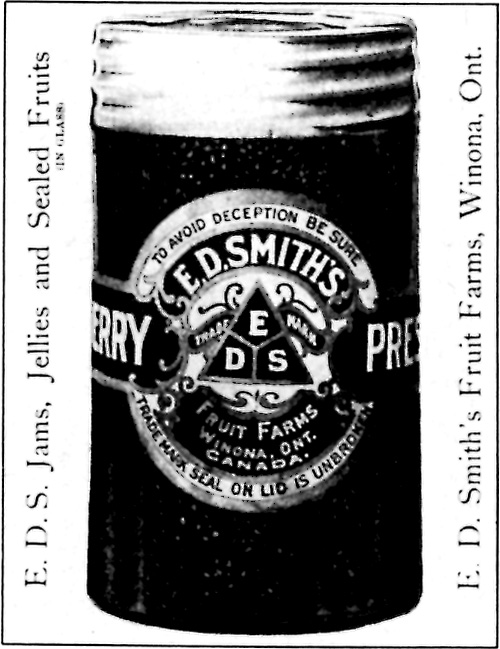
52 E.D. Smith cherry preserves (probably one pint), 1905.
(Canadian Grocer, Vol. 19 [March 1905], p. 55.)
|
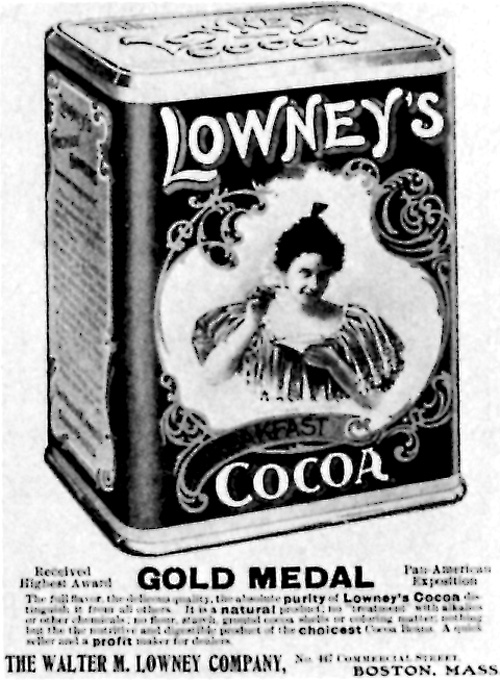
53 A half-pound tin of cocoa.
(Canadian Grocer, Vol. 18 No. 1 [January 1904], p. 7.)
|
With the packaging of staple goods in standard units,
the standard case lot followed as a natural consequence. This provided
a measure of efficiency in shipping, storage and wholesaling. In fact
the photograph of the NC Company grocery department (Fig. 39) shows that
packing cases were brought into the store and incorporated right into
the displays. The transaction of moving goods from warehouse to shop
was much easier than it had been in the days of bins and scoops. The
case lot could be opened for display and small purchases or it could be
sold as a unit, as often happened in sales to miners from the
creeks.
The standard case lot of cereals consisted of 36
boxes of either one or two pounds each; biscuits were packed in lots of
four dozen 2-pound boxes. A case of cocoa had 24 half-pound tins; a
case of baking powder was 36 8-ounce tins or 12 16-ounce tins or 6
2-1/2-pound tins. A case lot of butter usually contained two dozen 2-pound
tins, while one of condensed milk comprised four dozen one-pound tins.
Case lots of tinned fruit and vegetables were usually made up of two
dozen of either the 2- or 3-pound size. T. Eaton and Company had a
case lot of half a dozen gallon tins as well (Fig. 54). Dried
fruits, both in Dawson and Eaton's catalogue, came packed in crates
weighing either 25 or 50 pounds (Fig. 55). Tinned meats were sold in a
variety of case lots, usually of one or two dozen of either the 1- or
2-pound size. Whole tins were packed directly into the cases, bottles
were wrapped first in a paper wrapper, often printed with the company's
name; "Lea & Perrins" wrappers had the company's name in blue ink
diagonally across the outside.63

54 Case lots of tinned fruits and vegetables put up by the T.
Eaton Company, autumn, 1909.
(The Archives, Eaton's of Canada Limited.)
|
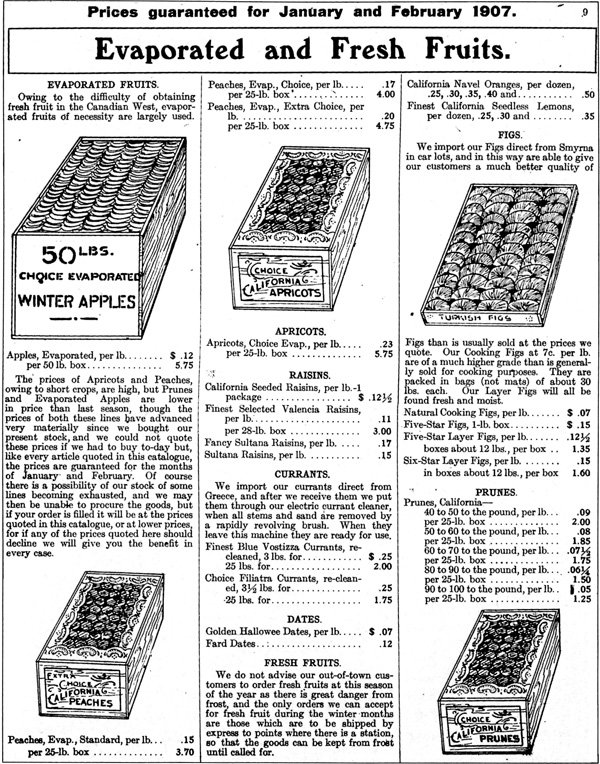
55 Case lots of fresh and evaporated fruits from the T. Eaton
Company, 1907.
(The Archives, Eaton's of Canada Limited.)
|
As F.C. Wade pointed out, one reason for the extensive American trade
with the Canadian Yukon was the progressiveness of its packing industry.
Lighter tin containers, more attractive label lithography, more reliable
packing of hams, cheeses and butter, all had their effect on the
competitive Dawson market.64 As late as 1905 the Canadian
Grocer took up the same issue with Canadian manufacturers who were
hoping to increase their shipments north.65
While increased convenience and tidiness were generally associated
with the transition to packaged foods, the quality of the food could be
affected too. A brief look at food standards has been taken above, but
many years after the outfitting rush, both retailer and consumer were
still plagued with adulterations and substitutions. While substitution
tended more to cheapen the product and add to its weight rather than to
introduce harmful substances, the common malpractice was gradually being
brought to public attention. Packaging had certainly cleaned up many
products, such as rolled oats, by sealing them off from the dirt which
naturally accumulated in any general store, but the practice of
additions and substitutions in the canning and packing industry was
still far from being eradicated.
A Canadian Grocer report in 1904 showed that of 74 tested
samples of jams and jellies, only four were found to contain nothing
more than fruit, cane sugar and water. The rest contained varying
amounts of turnip, glucose, coal tar, dyes and salicylic acid (the last
two of which are noxious).66 The same report showed that 100
out of 188 samples of various spices contained stone husks, shells,
sweepings, charcoal, hair or dirt. The following common adulterants were
singled out:
|
| Original | Adulterant |
|
| olive oil | cotton seed oil |
|
| maple syrup | brown sugar |
|
| maple syrup | glucose, sugar, water |
|
| pepper | stones, pulverized nut shells |
|
| jellies, jams | apple jelly, artificial colouring |
|
| baking powder | terra alba |
|
An early issue of the Grocer told of chicory in coffee (a
practice which was widely accepted at the turn of the century), acid in
vinegar, starch in mustard, old sugar covered by new and boric acid in
butter.67
Of course not all food complaints could be passed
over as the responsibility of the manufacturer. Laura Berton tells of a
well-known Dawson fruit dealer who "for a fabulous price . . . could sell
you a deep box of fruit, the top layer perfect specimens, and all
underneath rotten, with a smile of angelic sweetness and a gracious
phrase of broken English."68 The trials of shipping and
storing perishables were apt to have adverse effects on those foods. One
lady complained of finding five or six bad eggs after paying $2.50 for a
dozen.69 The taste of the eggs could be completely ruined by
poor packing procedures. For example, if jack pine was used for the
crates instead of basswood or elm, damp weather caused the eggs to
absorb a very nasty odour. Egg crates, the ever-watchful Grocer
warned, had to be well-constructed and ventilated, since breakages
could release a dreadful and permeating smell.70 Cheese boxes
needed continual inspection, especially in warm weather; unless they
were cool and dry, gases could form. When this happened, the merchant
was instructed to use a wire to poke a hole in the cheese to give vent
to the gas. Mould had to be scraped off, and the surface rubbed with
sweet oil.71
The average Dawson resident was cautious about what
he bought, not because he was an overly fussy customer, but because his
experiences with frozen outfits, tinned or cold storage foods, goods
shipped over several thousand miles (not to mention his encounters with
poorly packed or adulterated products) had made him acutely skeptical at
the grocery counter. While the merchant could never wax too descriptive
in his newspaper advertisements, he did recognize the prevailing
insistence on purity and worked his slogans around that demand.
"Warranted perfectly pure," "everything we sell is guaranteed" and "no
goods are sold over our counter until we have personally
sampled them and found them to be good" were common phrases in
newspaper columns. Some merchants were more blunt. The AC Company in 1900
advertised "Bro-man-get-on" as "a delicious dessert jelly, absolutely
pure ... no injurious adulteration." This store refunded money
to the dissatisfied customer as a policy,72 as did the Ames
Mercantile Company. Weld's Minnesota Grocery claimed in 1902 that
"adulterations are barred out and pure groceries are sold at very
moderate prices."73 In general, goods were advertised as
fresh, palatable, nourishing, wholesome, good, of the finest or highest
grade — or any combination of these.
Even in making his actual purchase the consumer had
to be careful, although the phasing out of bulk goods alleviated much of
the need for surveillance at the scales. The Dawson customer had added
cause for caution, at least as long as he was dealing in gold dust. The
understanding which existed between merchant and customer in this
ritual has been discussed in the preceding chapter. The eventual
insistence on hard currency as tender also contributed to the reduction
of this worry. In the early days of Dawson trade, the scales — for
dust and for goods — were among the most conspicuous features in a
commercial establishment, for a variety of goods from beans and
blankets to soap and candles was sold by the pound.74
Romantic though they may have been, the gold scales were the first to
go. They were replaced by one product from an up-and-coming company in
Dayton, Ohio, which was already working its way into many a North
American store. In 1898 the National Cash Register Company was retailing
its wares at $50 to $70 in Vancouver.75 Two years later,
McLennan and McFeely were selling these machines to any merchant who
wished to modernize his business.
The Canadian Grocer thought that the efforts
of even the best-intentioned merchant to present his goods in an
attractive fashion would be totally wasted if he did not ensure that
the interior of his store was brilliantly illuminated. By 1900, however,
a large number of Dawson firms were able to convert to electric lighting
using the power supplied by the Dawson Electric Light and Power Company.
In January, the AE Company had 50 lights installed, the SYT Company
had 40 and the Ames Mercantile Company had 20. Rowe and Townsend
(cigars and tobacco), the Melbourne Annex Lunch and the Criterion Hotel,
as well as several other hotels, offices, homes and stores on Second
Avenue, were also among the first to convert.76 Two large
corporations had already hooked up their own electric lighting.
Most Dawson stores were dependent for their large,
centrally located stoves, which (naturally enough) became the social
focus of the establishment. The larger department stores could not rely on
this method of heating for their huge retail outlets. Many of them
turned to the steam heat generated several blocks away at the Yukon Saw
Mill. The old AE store, which became the hardware department of the NC
Company, got its heat from one 100-horsepower and two 75-horsepower
boilers. The connecting pipe was wrapped in asbestos and placed in a
12-inch box packed with sawdust. Radiators in every room supplied the
heat. The company could claim proudly that they needed not one single
stove.77
One important aspect of the store's immediate appeal
to customers was the way it smelled. While the merchant had probably
grown accustomed to the olfactory jungle in which he worked, he had to
take care that the total effect was not overwhelming. The
Grocer suggested that foods emitting the most powerful odours (cheese and
pickled goods, for example) be kept near the rear, that dried fruits be
covered, that confectionery be kept under glass and that the sugar be
checked regularly for melting and souring around the wood. At least one
Dawson grocer discovered that, if he roasted his own coffee daily, the
pleasant aroma would manage to dominate all the others.78
Food was not necessarily the only concern of the
grocery and provisions merchant. T.W. Grennan, as has been shown,
carried a considerable stock of household supplies; Germer stocked
tobaccos — although the competition from confectioners and
tobacconists must have been stiff. The following was considered to be a
full slate of the household items offered by one merchant in 1899:
stoves and ranges
kitchen utensils
wringers
clothes pins
potato mashers
wash boilers
flour sifters
muffin tins
portable forges
stove furniture
knives and forks
wash boards
rolling pins
coffee mills
tubs and pails
lemon squeezers
cork screws79
While these items were more in the line of the
hardware merchant than the grocer's, the latter stocked everything
possible in household hardware equipment. The Dawson Hardware Company
Museum contains a "kitchen reminder" issued by Ahlert and Forsha
grocers. It contained such useful items as alum, blacking, blueing,
lamp wicks, lye, stove polish and washing powder.
The appearance of rubber boots in the middle of the
NC Company's grocery department (Fig. 39) is something of a mystery,
given a department store which had a section exclusively devoted to
Klondike clothing — especially since goods and clothing were among
the earliest specializations in Dawson business. Newspaper
advertisements placed by such clothiers as J.P. McLennan, Sargent and
Pinska, Oak Hall Clothing, Hershberg and Company and Red Front Store
were consistently prominent.
The most fundamental truism of Dawson business was
that prices were exceedingly high, both on the wharves in 1898 and in
major department stores a decade later. At this point the basis of the
problem should be fairly clear. Appendix J has been compiled from the
numerous references which had been made to the price of commodities over
the years. Many of these were accompanied by complaints; many more were
included in letters to shock the folks at home. A cursory study of this
appendix brings a number of trends to light. The most evident is the
monstrous gap which separates Dawson's retail prices from those in
outfitting centres or in the Eaton's catalogue. The analysis of
shipping and distribution conditions already given justifies to some
extent Dawson's comparatively exorbitant prices. An indirect effect of
long-distance shipping on prices was the need for Dawson's merchants to
bring in the highest quality and most climate-resistant goods. Another
way of looking at the same set of circumstances was to observe that,
with freight rates so high, it never paid to bring in anything but the
best.80
Another trend made obvious by Appendix J is that by
1907 prices had dropped considerably. Consequently, in some lines
(especially canned fruit and vegetables) Dawson prices appeared to be
nearly competitive with those in Eaton's catalogue. Explanations for
this phenomenon are various. In general, the entire mercantile
structure had been adjusted by 1907 to fit Dawson's population
comfortably; that is, a settled trade operation was able to predict and
provide for the needs of a more stable population. There were particular
factors involved as well, including the reduction of rail rates and the
insistence on cash or short-term payment — changes which created a
more suitable system for the businessman dealing in the modern business
world. The character of the merchant himself was also a consideration,
for everyone agreed that the boom days of speculation and sudden,
immense profits had come and gone. In these and many other ways, Dawson
was taking on the appearance and character of any contemporary Canadian
town.
Nonetheless, the prices charged for staples after
1903 were in no way readily accepted by Dawson's citizens. "You can buy
as handsome things here as in San Francisco or New York, if you don't
mind the price," one visitor wrote coolly,81 but Dawsonites
themselves could not afford to be so nonchalant. From all sides came
repeated criticism that merchants, like landowners, refused to lower
their prices in keeping with the general depressing effect of falling
wages. There were, of course, instances — usually corresponding
with general shortages, such as that felt over the winter of 1899 —
when merchants were actually accused of cornering the market and
deliberate price manipulation.82 During a suspected meat
combine in 1900 the Dawson Daily News took up the cause of the
"labouring classes" who could not afford the $1 and $1.50 per pound
which was being charged for meat, and whose families, it was argued,
hardly received enough nutrition from the cheaper moose and
caribou.83
The comparative price chart (Appendix J) has been set
up in such a way as to bring out one striking pattern of Dawson prices,
seasonal variation, for the years 1897, 1902 and 1905. Without exception
winter prices are higher during these years. The winter of 1897 (the
"starvation winter") is an especially dramatic example of this
phenomenon, and the price of flour most accurately reflects the pattern.
As winter drew to a close, scows of provisions were dragged over the ice
or were sent to Dawson immediately after breakup; the market broke, and
prices returned to normal. The price of flour, for example, dropped to a
startling low of $2.00 per 50 pounds.
It is difficult to follow the sensitive reactions of
retail prices to yearly market fluctuations. For instance, the end of
the winter might mean that one line of goods (Carnation cream, perhaps)
had been sold right out while overstocked canned goods, such as
vegetables, were selling at rock-bottom prices in an attempt to clear
them out before the arrival of fresh goods over the ice and the summer
pack of canned goods. Such was the case in April 1902 when the Dawson
Daily News declared that "staples are cheaper than ever in the
history of the country,"84 and commission grocers were
practically giving their stocks away. The arrival of goods over the ice
from Laberge did much to re-establish equilibrium in the market. By the
end of May and June, prices in fresh goods and perishables were as low
as they ever would be.
This basic pattern was played out annually. Once the
structure had been established, improved and stabilized, once the city's
tastes and needs had been formed and recognized, and once the number of
participating merchants had reached a level commensurate with the
reduced population, the machine was virtually self-perpetuating. As
Dawson settled into its respectable middle age, its customers resigned
themselves to the constant features of northern trade. Clark's "Ready
Lunch Beef," Borden's "Eagle Brand" milk and the ubiquitous canned
fruits would be with them always. Those who carried such commodities
inside as part of their outfits had not been aware at the time of the
precedent they were setting. Years later, if they were still in Dawson,
they had no doubt resigned themselves to a northern diet which was, at
best, tinned and boxed.
|

